Angiotensin ii stimulates - Study guides, Class notes & Summaries
Looking for the best study guides, study notes and summaries about Angiotensin ii stimulates? On this page you'll find 1355 study documents about Angiotensin ii stimulates.
Page 2 out of 1.355 results
Sort by
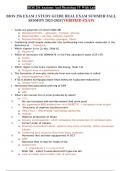
-
BIOS 256 EXAM 2 STUDY GUIDE REAL EXAM SUMMER FALL SESSION 2023-2024 |VERIFIED EXAM
- Exam (elaborations) • 9 pages • 2023
-
Available in package deal
-
- $13.49
- 1x sold
- + learn more
BIOS 256 EXAM 2 STUDY GUIDE REAL EXAM SUMMER FALL SESSION 2023-2024 |VERIFIED EXAM 1. Carbs are polymers of what? Slide 28? a. Monosaccharides – galactose, fructose, glucose b. Disaccharides = sucrose, maltose, lactose c. Polysaccharides = starches, glycogen, fibers 2. Combining small simple molecules into synthesizing into complex molecules is the definition of Anabolism. 3. Which vitamin is for Ca abs. Slide 62 a. Vitamin D 4. Which of hormones will DOMINATE in the Post absorptive ...
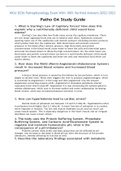
-
WGU D236 Pathophysiology Final Exam // D236 Pathophysiology Lesson 1 TO Lesson 11 (100% Verified Answers) 2022/2023
- Exam (elaborations) • 32 pages • 2022
-
- $11.49
- 1x sold
- + learn more
WGU D236 Pathophysiology Final Exam // D236 Pathophysiology Lesson 1 TO Lesson 11 (100% Verified Answers) 2022/2023 1. What is Starling's Law of Capillary forces? How does this explain why a nutritionally deficient child would have edema? Starling’s Law describes how fluids move across the capillary membrane. There are two major opposing forces that act to balance each other, hydrostatic pressure (pushing water out of the capillaries) and osmotic pressure (including oncontic pressure, which ...
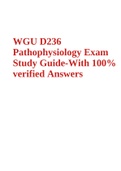
-
WGU D236 Pathophysiology Exam Study Guide-With 100% verified Answers
- Exam (elaborations) • 29 pages • 2023
-
Available in package deal
-
- $13.49
- 1x sold
- + learn more
WGU D236 Pathophysiology Exam Study Guide-With 100% verified Answers. How does the RAAS (Renin-Angiotensin-Aldosterone System) result in increased blood volume and increased blood pressure? A drop in blood pressure is sensed by the kidneys by low perfusion, which in turn begins to secrete renin. Renin then triggers the liver to produce angiotensinogen, which is converted to Angiotensin I in the lungs and then angiotensin II by the enzyme Angiotensin-converting enzyme (ACE). Angiotensin II ...
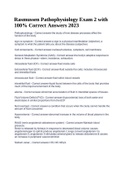
-
Rasmussen Pathophysiology Exam 2 with 100% Correct Answers 2023.
- Exam (elaborations) • 6 pages • 2023
- Available in package deal
-
- $9.99
- 1x sold
- + learn more
Rasmussen Pathophysiology Exam 2 with 100% Correct Answers 2023. Pathophysiology - Correct answer-the study of how disease processes affect the function of the body sign vs symptom - Correct answer-a sign is a physical manifestation (objective), a symptom is what the patient tells you about the disease (subjective) Cell components - Correct answer-nucleus/nucleolus, cytoplasm, cell membrane General Adaptation Syndrome (GAS) - Correct answer-the body's adaptive response to stress in three...
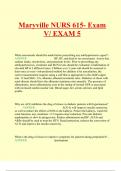
-
Maryville NURS 615- Exam V/ EXAM 5
- Exam (elaborations) • 37 pages • 2024
- Available in package deal
-
- $10.49
- + learn more
Maryville NURS 615- Exam V/ EXAM 5 What assessments should be made before prescribing any antihypertensive agent? - ANSWER BP, RF, and head to toe assessment. Assess diet, sodium intake, electrolytes, and potassium levels. Prior to prescribing any antihypertensives, creatinine and BUN levels should be evaluated. Confirmation of elevated BP at 3 different times. Children over 3 years old should be assessed at least once at every visit-prefer...
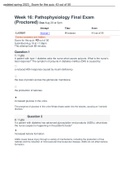
-
SCI 225 Pathophysiology - Week 16: Pathophysiology Final Exam (Proctored) Score for this quiz: 43 out of 50
- Exam (elaborations) • 25 pages • 2023
-
Available in package deal
-
- $9.49
- 3x sold
- + learn more
Week 16: Pathophysiology Final Exam (Proctored) Due Aug 20 at 5pm Attempt Time Score LATEST Attempt 1 89 minutes 43 out of 50 Correct answers are hidden. Score for this quiz: 43 out of 50 Submitted Aug 19 at 11:06pm This attempt took 89 minutes. Question 1 1 / 1 pts A patient with type 1 diabetes asks the nurse what causes polyuria. What is the nurse’s best response? The symptom of polyuria in diabetes mellitus (DM) is caused by: a reduced ADH response caused by insulin deficiency....
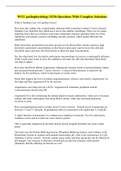
-
WGU pathophysiology D236 Questions With Complete Solutions
- Exam (elaborations) • 31 pages • 2022
-
Available in package deal
-
- $12.49
- 1x sold
- + learn more
What is Starling's Law of Capillary forces? How does this explain why a nutritionally deficient child would have edema? Correct Answer: Starling's Law describes how fluids move across the capillary membrane. There are two major opposing forces that act to balance each other, hydrostatic pressure (pushing water out of the capillaries) and osmotic pressure (including oncontic pressure, which pushes fluid into the capillaries). Both electrolytes and proteins (oncontic pressure) in the bl...
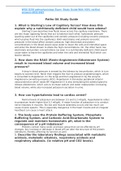
-
WGU D236 pathophysiology Exam -Study Guide-With 100% verified answers-2022-2023
- Exam (elaborations) • 26 pages • 2022
-
- $9.79
- 4x sold
- + learn more
1. What is Starling's Law of Capillary forces? How does this explain why a nutritionally deficient child would have edema? Starling’s Law describes how fluids move across the capillary membrane. There are two major opposing forces that act to balance each other, hydrostatic pressure (pushing water out of the capillaries) and osmotic pressure (including oncontic pressure, which pushes fluid into the capillaries). Both electrolytes and proteins (oncontic pressure) in the blood affect osmot...

-
Question And Solution Paper NUR426: Exam 2 2024/2025
- Exam (elaborations) • 67 pages • 2024
-
- $14.99
- + learn more
Functions: Renal System Answer: -Filters plasma -Regulates blood volume and blood pressure: conserving and excretion of water -Secretes renin: Triggers RAAS system to increase blood pressure: vasoconstriction and retention of Na+ and water with release of aldosterone, triggers ADH -Secretes erythropoietin: stimulates RBC production -Acid-base balance regulation: Reabsorption of HCO3- and secretion of H+ ions -Synthesis of calcitriol (activated form of VD): conserves dietary calcium ...
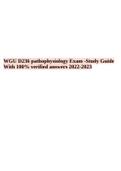
-
WGU D236 pathophysiology OA Exam -Study Guide With 100% verified answers 2022-2023.
- Exam (elaborations) • 28 pages • 2023
- Available in package deal
-
- $10.99
- 1x sold
- + learn more
WGU D236 pathophysiology OA Exam -Study Guide With 100% verified answers 2022-2023. Patho OA Study Guide 1. What is Starling's Law of Capillary forces? How does this explain why a nutritionally deficient child would have edema? Starling’s Law describes how fluids move across the capillary membrane. There are two major opposing forces that act to balance each other, hydrostatic pressure (pushing water out of the capillaries) and osmotic pressure (including oncontic pressure, which p...

$6.50 for your textbook summary multiplied by 100 fellow students... Do the math: that's a lot of money! Don't be a thief of your own wallet and start uploading yours now. Discover all about earning on Stuvia


